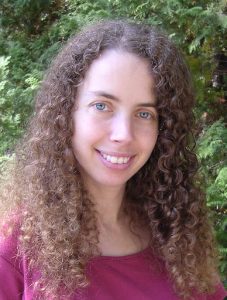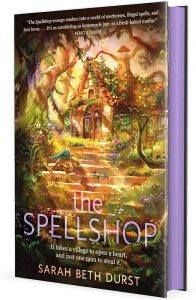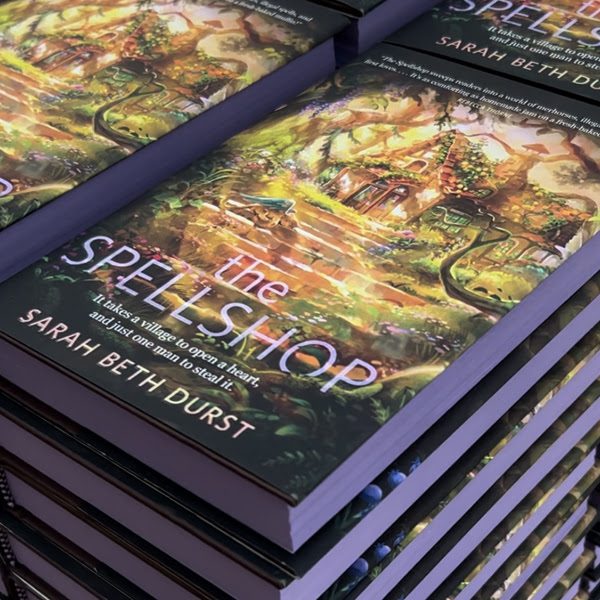Book Review: Sarah Beth Durst’s latest novel, ‘The Spellshop,’ celebrates the power of books
Reviewed by Jeffrey Sanzel

It is no surprise that Sarah Beth Durst’s latest novel forges intriguing new territory. The gifted author of over two dozen books (six reviewed in this publication) has penned a highly original fantasy novel: The Spellshop. While fantasy is not new terrain for Durst, she has populated her world with a blend of magic and humanity, creating a delightful but wholly grounded universe.
Librarian Kiela is at the center of The Spellshop. She lives in Alyssium, the capital of the Crescent Island Empire, where freedom fighters instigated a revolution to bring free elections and knowledge sharing.
As the novel opens, the Great Library of Alyssium is on fire. “Its hallowed stacks were filled with centuries-old treatises, histories, studies, and (most importantly, in Kiela’s opinion) spellbooks. Only the elite, the crème de la crème of the scholars, were allowed to even view the spellbooks, as only the rarefied few were permitted, by imperial law, to use magic.” The narrative hinges on this last point.
Kiela gathers up five crates of books and her sentient spider plant pal, Caz, and escapes in one of the library’s boats, heading to her birthplace, the island of Caltrey. “Behind them, the great city burned, with its people (both good and bad) and its history (both good and bad) and its books and its flowers. And she knew she wasn’t coming back.” Durst deftly sets the story in motion with quick, tense strokes, evoking a perfect intersection of fantasy and reality.
Kiela arrives on Caltrey, taking up residence in the family’s long-abandoned cottage. A loner by nature (and afraid of anyone discovering her literary contraband), she is reluctant to connect with the locals. “It wasn’t that she didn’t like people. It was only that she liked books more.”
To her dismay, Kiela discovers that her native island is depressed and desperate. Bryn, the local baker, shares with her the current state: “It used to be that the emperor would send his sorcerers on a regular rotation to tend to the outer islands, and they’d cast spells that balanced whatever nonsense they’d done in the capital city to throw them out of whack, but then they stopped coming.”
This absence resulted in a scarcity of fish, dangerous changes in weather patterns, and depletion of crops. The capital’s abandonment of its responsibilities leads Kiela to the realization that “no matter who was in charge, the powerful always wanted to keep power for themselves.”
With serious poverty looming, Kiela delves into the rescued and forbidden tomes. Creating a jam shop as a front, she embarks on healing many of Caltrey’s problems, claiming her magic offerings are “old family remedies.” In Alyssium, Kiela was friendless by choice. Gradually, in Caltrey, she finds a welcoming community, a circle of friends, and a new sense of self. Eventually, the outside world threatens the enclave in the specter of imperial investigators.
Along the way, romance appears in the form of her neighbor, Larran, the strapping merhorse herder and jack-of-all-trades. At first, she resists any interaction and then questions if he—or anyone—could be interested in her. But collaboration blossoms into more than just companionship.
 Durst populates The Spellshop with a wonderful integration of the expected and fantastical. Here, four-armed harpists dwell side-by-side with centaurs. The forest is full of cloud-like bear spirits and unicorns. Winged cats take up residence on roofs and shelter in attics during storms.
Durst populates The Spellshop with a wonderful integration of the expected and fantastical. Here, four-armed harpists dwell side-by-side with centaurs. The forest is full of cloud-like bear spirits and unicorns. Winged cats take up residence on roofs and shelter in attics during storms.
Possibly Durst’s greatest creation is the resourceful but angst-ridden spider plant, Caz, whose first words in the novel are “We’re going to die.” The anthropomorphic sidekick is hilarious, strangely human, and unique. “[Caz] crossed his leaves like a professor, preparing to listen to a student’s wildly incorrect theories. All he needed was a pair of wire-rimmed glasses perched on his roof to complete the look.” (Later, he is joined by a non-binary cactus whose sole vocal communication is the single word, “Meep.”)
The Spellshop celebrates the power of books: Anything can be accomplished by reading, researching, and studying. “If everyone failed her, whatever they did, she had all the immortal voices caught in pages.” However, Kiela learns that it is not solely what you learn but the application of that knowledge. Her life transforms from clerical and theoretical to harnessing information in active, productive, far-reaching results.
Ultimately, the story traces Kiela’s emergence from a narrow and disconnected academic to a risk-taking hero embracing life. Durst writes with rich, engaging prose; even her most whimsical ideas resonate with deep truth. The story takes on several contemporary issues in subtle but formidable ways. She highlights sustainability. It is not who you love but how truly you care. Parallels between magic and science are sharply drawn. Laws should protect and elevate the population and keep it safe. And, finally, that “law” and “right” are not synonymous—but should be.
The Spellshop is a far-reaching and insightful novel that speaks great and important truths. But, first and foremost, it is a terrific read.
Pick up a copy online at www.amazon.com or www.barnesandnoble.com. For more information, visit sarahbethdurst.com.







